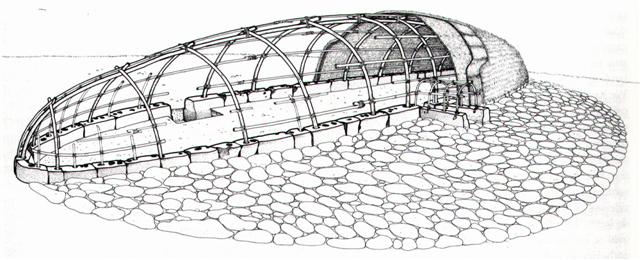|
2.
Fists should be held high, but in pare the outline
of a 'cup' necessitates holding them low:
|
 |
|
pare |
The crown of flames
presumably serves to illustrate how Sun is hidden but on his way up. There are
3 flames high up and 2 in a lower position. Those at the top could
refer to summer and those lower down to winter.
The 2 mata are holes and possibly the 2 fists are his eyes.
By holding his fists low we are able to associate to waterfilled
bags (hipu). When Sun is crying his tears flow downwards in
form of rain, as described for instance by the Moriori
fishermen (Legends of the South Seas):
"In the
beginning were Rangi and Papa, Sky and Earth.
Darkness existed. Rangi adhered over Papa his
wife. Man was not. A person arose, a spirit who had no origin;
his name was Rangitokona, the Heaven-propper. He went to
Rangi and Papa, bid them go apart, but they would
not.
Therefore Rangitokona separated Rangi and Papa,
he thrust the sky above. He thrust him with his pillars ten in
number end to end; they reached up to the
Fixed-place-of-the-Heavens. After this separation Rangi
lamented for his wife: and his tears are the dew and the rain
which ever fall on her ..."
The separation of heaven and earth begins with spring equinox. The
ecliptic path of the Sun from then on forces him higher and higher
away from the earth. The great 'eye-lid' is opening.
Fornander was probably right, the Hawaiian pale (pare) has to
do with the eye:
... Greek, φαρος,
a large cloth, cloak, or mantle, shroud;
παλλω,
to sway, swing, poise, toss;
παλμη,
a shield; παλμος,
a quivering motion, vibration,
palpitation; πελτη,
a small shield; πελεμιζω,
shake, make to quiver, drive away ...
... And though these gentlemen refer
βλεφαρον,
the eyelid, and βλεφαρις,
the eyelash, to the verb βλεπω,
to see, look, I would, in view of the
foregoing pale,
παλλω,
pello,
and their derivatives, consider these
words as composite rather than as
derivatives of βλεπω,
and formed from βλεπω
or βλεμμα,
and φαρος,
originally perhaps βλεπ
(or βλεω-)
φαρος
= the covering of the eye ...
The covering (pare) of the eye, the eye-lid, is similar to 'the cap of
the sky', it can close and cause darkness. It is like a dark veil. Another image for
the cap is hare paega:
...
Ure set out and arrived in front of the house of Tuu
Ko Ihu. Ure said to the king, 'I (come) to you for my
very large and very beautiful skull, which you took away on the
day when the banquet for the new house was held. Where is the
skull now?' (whereupon) Tuu Ko Ihu replied, 'I don't
know.'
When
Tuu Ko Ihu came out and sat on the stone underneath which
he had buried the skull, Ure Honu shot into the house
like a lizard. He lifted up the one side of the house. Then
Ure Honu let it fall down again; he had found nothing.
Ure Honu called, 'Dig up the ground and continue to search!'
The search went on. They dug up the ground, and came to where
the king was. The king (was still) sitting on the stone. They
lifted the king off to the side and let him fall. They lifted up
the stone, and the skull looked (at them) from below. They took
it, and a great clamour began because the skull had been found.
Ure Honu went around and was very satisfied. He took it
and left with his people. Ure Honu knew that it was the
skull of the king (puoko ariki) ...
The Marquesan dialect has pae for pare.
A hare paega has the shape of the sky dome and in front of it
is a two-dimensional representation (like its shadow) in form of
paega:

At the ancient site of Orongo a weeping god is depicted (cfr
at hua poporo):

Also
Posnansky (cfr at vai) was right. He was certain that the
motive of the 'weeping eye' in South America was a way of showing
how the eye of the sun god was quickly moving. Time is beginning
when sky and earth separates, when the dark cloth of winter (the
primal embrace) is forced away. With 'dawn' comes the 'cock crying
out' (moa), and according to the Moriori fishermen his
tears are caused by Sky lamenting for his lost wife (his
winter maid far north). And these tears came after the separation
was complete.
The hipu fists of pare should belong not
in winter but rather in spring, which explains why the fist
are in a low position. Sun has come closer by following his path
from a beginning far away in the north. From spring equinox this
path happily also goes upwards - otherwise he would burn the island
when he reached it.
The myths say Sun's tears will come
only after the full separation is accomplished, when the tears will
impregnate the dry hot earth. The case is
complicated, however.
|